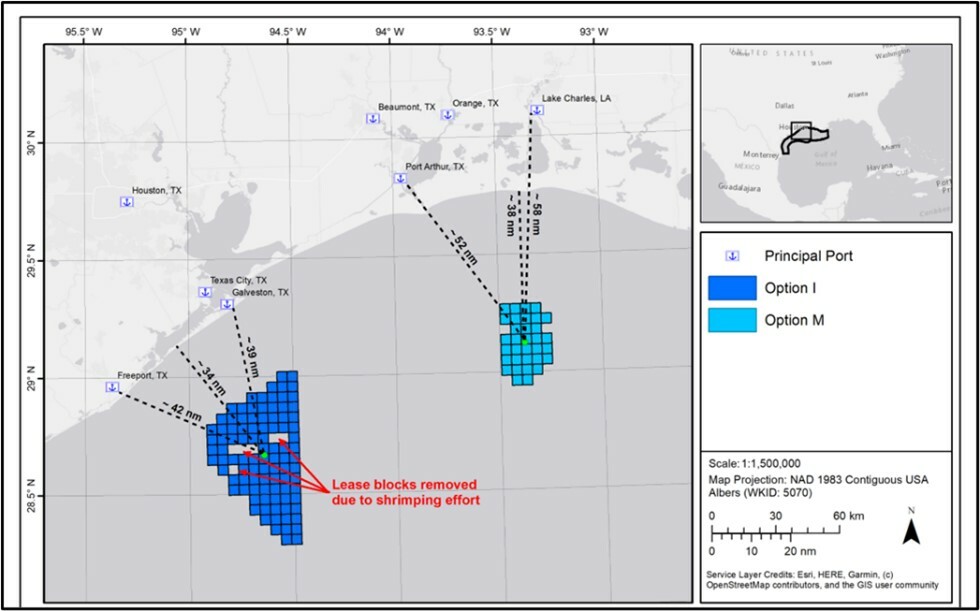Nearly 1,150 square miles in the western Gulf of Mexico are proposed for offshore wind energy areas (WEAs), as President Biden said he would do everything within his executive powers to act on climate issues and developing cleaner energy.
With heat waves nationwide putting 100 million Americans in 90-degree-plus temperatures this week, Biden went to the site of a former coal plant in coastal Massachusetts yesterday to announce a new push on offshore wind.
The cumulative effect of climate change “is definitely a clear and present danger,” Biden said at Brayton Point in Somerset, Mass., where the old generating site is being redeveloped to manufacture power cables for wind projects off southern New England.
“We see it in America, in red states and blue states,” said Biden, “seeing 100-year droughts happening every few years” and massive damage from hurricanes. “This is an emergency and I’ll look at it that way.”
Speaking from a podium on the old coal plant site, Biden said it used to generate “the kind of pollution that contributed to the climate emergency we’re in now.”
“Today Brayton Point is on the frontier of clean energy,” he said. In a speech peppered with references to construction jobs, shipbuilding and new manufacturing, he called the site on example of future economic opportunity.
“When I think clean energy, I think jobs,” said Biden.
Timed with Biden’s address, yesterday the Department of the Interior's Bureau of Ocean Energy Management (BOEM) announced it was seeking public input on the identification of two potential WEAs in the Gulf of Mexico (GOM).
“The promise of renewable energy is undeniable, as is the momentum for a clean energy transition,” Secretary of the Interior Deb Haaland said in a statement. “Today’s announcement in the Gulf of Mexico is one of many commitments we are making to spur innovation, create good-paying jobs, and collaborate with states, Tribes and communities to ensure that we are doing everything we can to care for our Earth.”
Over the past year, the Biden administration has launched the American offshore wind industry by approving and celebrating the groundbreaking of the nation’s first two commercial-scale, offshore wind projects in federal waters. By 2025, the Interior Department plans to potentially hold up to five additional offshore lease sales and complete the review of at least 16 plans to construct and operate commercial, offshore wind energy facilities, which would represent more than 22 gigawatts of clean energy for the nation.
“BOEM used the most current scientific data to analyze 30 million acres in the Call Area to find the best spaces for wind energy development. We are invested in working in partnership with states and communities to find areas that avoid or minimize conflicts with other ocean uses and marine life in the Gulf of Mexico,” said BOEM Director Amanda Lefton. “We are committed to a transparent, inclusive and data-driven process that ensures all ocean users flourish in the Gulf.”
The first draft WEA is located approximately 24 nautical miles (nm) off the coast of Galveston, Texas. The area for review totals 546,645 acres and has the potential to power 2.3 million homes with clean wind energy. The second draft WEA is located approximately 56 nm off the coast of Lake Charles, La. The area for review totals 188,023 acres and has the potential to power 799,000 homes, BOEM said.
The two draft WEAs represent a subset of the original 30-million acre Gulf of Mexico Call Area that the Department of the Interior announced for public comment in October 2021. The draft WEAs were reduced to avoid potential impacts on other ocean uses and resources, such as commercial and recreational fishing, maritime navigation, military activities, marine protected species, avian species, and existing infrastructure.
Public comments on the draft WEAs will be accepted for 30 days, which began July 20, 2022.
In addition to the draft WEAs, BOEM has prepared a draft environmental assessment (EA) covering the entire call area to consider the potential impacts from site characterization (e.g., marine mammal surveys) and site assessment (e.g., installation of meteorological buoys) activities expected to take place following lease issuance. The EA analysis will inform potential lease stipulations necessary to address identified environmental impacts associated with offshore wind leasing activities. Public comments on the draft EA will also be accepted for a 30-day period that began July 20, 2022.
During the comment period, BOEM will hold two virtual public meetings where the public can learn more about the environmental review process. There will also be an opportunity for participants to ask questions and provide comments on the draft EA.
Information about how to register for the public meetings, and instructions for how to submit questions and comments can be on BOEM’s Gulf of Mexico Renewable Energy webpage.




